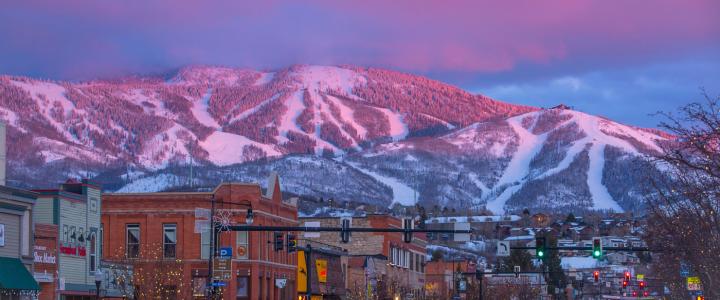
Visitors have been coming to Steamboat Springs and the Yampa Valley for hundreds of years. In fact, well before our snow was coined Champagne Powder® and our modern visitor amenities emerged, the Yampa Valley was the summer hunting grounds of the Ute Indians. Even then the mineral springs lured visitors, including the Yampatika Ute and Arapaho tribes. The tribes enjoyed the therapeutic qualities of the springs and considered them sacred places of therapy and healing.
These same minerals and hot springs later led to the modern-day naming of Steamboat Springs. Ever wondered why a town in the middle of the Rocky Mountains is named after a type of boat? The resemblance in sound and sight of a geyser-like hot spring caused French trappers to name the region Steamboat after the chugging sound they heard. By the 1870s, all those who passed through the area—trappers, explorers, miners, and settlers—referred to it as Steamboat Springs.
One such settler, again captivated by the abundant mineral springs, was James Crawford. James Harvey Crawford moved his family from Missouri to Steamboat Springs in the 1870s. He managed to convince a government agent that the springs were of no value and obtained the patent on his claim in 1876. He discovered the spring that now occupies the site of Old Town Hot Springs in downtown Steamboat Springs and called it the “Bath Spring”. The first log structure was built in 1885 but was then boarded over and a newer frame building was constructed in 1887.
In 1900, the town was incorporated with James Crawford as the first mayor. By 1902, the town had 3 hotels, 3 livery stables, 3 banks, 4 general stores, 2 meat markets, and a few businesses. But it wasn’t long before the word got out about this incredible new town — it just took a different form of transportation to bring people here.
Tourism Arrives
The arrival of the Denver, Salt Lake, and Pacific Railroad in 1908 created a tourism boom. Before the railroad arrived, visitors often came by stagecoach. The Steamboat Springs Visitor Center houses an original 1890 stagecoach — come take a look next time you visit and imagine riding 150 miles over rugged terrain in that! One of the top tourist attractions in the area was a visit to the Steamboat Hot Springs. To provide an inviting atmosphere for guests, the town remodeled the facilities to include a large outdoor pool and a new bathhouse with smaller private pools and steam rooms. If you come to town looking for the fabled chugging noise, you’ll be disappointed: the building of the railroad ceased the chugging sounds
Howelsen Hill and Ski Town USA®
The next type of visitors to arrive in Steamboat Springs were after water in a different form. In the early 1910s, Norwegian skiing pioneer Carl Howelsen brought the sport of ski jumping to Steamboat Springs. Before his arrival, skiing was mostly a means of getting around in the deep snow in winter. Locals and visitors alike soon took to ski jumping and recreational skiing, and the area quickly become known as a skiing destination. Howelsen left his mark on the area with his name too, with a local ski area named after him. Acclaimed for its ski jumping facilities, Howelsen Hill later added downhill courses and tow lifts. In the 1960s, Storm Mountain was developed as a ski resort by local rancher Jim Temple. Engineered and largely constructed by another rancher, John Fetcher, the new ski hill was opened with only a poma lift and an A-frame cabin as a warming hut. Storm Mountain was renamed Mount Werner honoring one of Steamboat’s first Winter Olympians, Buddy Werner, who was tragically killed in an avalanche in Switzerland in 1964.
Champagne Powder®
Ever wonder where the phrase Champagne Powder® came from? In the 1950s, after a day on the mountain, local rancher Joe McElroy said the snow tickled his nose like champagne. The snow we enjoy in Steamboat has very low water content, so it’s nice and dry and might just tickle your nose. We’ll let you decide if it feels like Champagne.
A Destination for Arts and Culture
The railroad also brought new opportunities for expanding the cultural side of Steamboat Springs. In 1913, Charlotte Perry and Portia Mansfield came to Steamboat Springs to teach natural dance forms and artistic expression in the beautiful surroundings of Strawberry Park. Though the legend is they came with a mule, the railroad afforded others a more comfortable option to travel to the newly created Perry-Mansfield Performing Arts School and Camp. Over 100 years later, the camp is the oldest continuously operating performing arts school and camp in the country and attracts over 250 students each year. Though the railroad has ceased to bring visitors to the area, it’s still supporting arts and culture in the area as home to Steamboat Creates.






